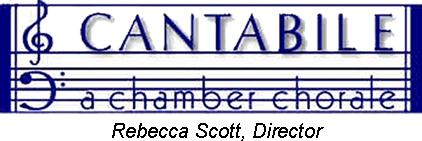Grant funding has been provided by the Middlesex County Board of County Commissioners through a grant award from the Middlesex County Cultural and Arts Trust Fund.
Project Notes: Psalms and Carols of Majesty and Mystery
Psalms and Carols of Majesty and Mystery
By Rebecca Scott with text translations by Bruce Bush
O Magnum mysterium – Tomas Luis de Victoria (1548ca-1611)
Although Tomas Luis De Victoria was born in Spain in 1548, he spent most of his musical career in Italy, arriving in Rome at the age of 17, where it is
thought, he may have studied wtih Palestrina and whom he succeeded at the Collegium Romanum. He returned to Spain in 1586 and served as a priest, choirmaster and organist at the convent in Madrid under the auspieces of the Empress Maria. His output was solely sacred and well received in his time. O magnum mysterium is a responsorial chant from the Matins of Christmas
O Regem coeli – Tomas Luis de Victoria (1548ca-1611)
O Regem Coeli: This motet was published in 1589, three years after Victoria returned to Spain and was composing for a convent. It is usually performed by four part women’s voices, but instead is sung here by four part men’s voices. It is the first of two motets from In Festo Natalis Domini (For the Feast of the Birth of the Lord)
Behold the Dark and Bitter Night – Thomas Fielding
This carol was composed for the 2003 Welcome Christmas! carol composition competition sponsored by VocalEssence (Philip Brunelle, artistic director) of St. Paul, Minnesota, and won one of the two first prizes offered that year. The text, written by composer calls for the world to awaken now, from the darkness of violence and to share the light of love: Behold this night! Composer and organist, Fielding, received a DM from the Indiana University Jacobs School of Music and can be contacted at www.tomasfielding.com
Cantata 140 by J.S. Bach
Wachet auf, ruft uns die Stimme was composed for a Sunday which occurred only twice during Bach’s service in Leipzig (1723-50). Perhaps for
this reason, it was not well known in its time. However, it was the first Bach cantata performed in the USA on May 11, 1903. The Bach Choir.of
Bethlehem (PA) opened its festival with this cantata. The opening, middle and last movements are based on the hymn text and melody by Philipp Nicolai (1550-1609). The tune appears in three different forms, moving from complex to simple, beginning in movement 1 with an elaborate choral fantasy accompanied by the orchestral line and the vocal polyphony. It is fun to note, that this movement is introduced by 12 double dotted chords, perhaps representing the hour of midnight when the watchmen call. In the 4th movement, the tune is accompanied by a now famous string counter-melody and in the 7th movement it is expressed in simple homophonic style. The parable is that of the ten virgins from Matthew 25:1-7, focusing on the wise virgins in the story, who brought oil for their lamps with them. We omit the first duet and therefore re-order the movements to provide smoother transitions. For Movement 1, Bach uses the first two stanzas of Nicolai’s hymn. The hymn and text were probably written in 1597, during the pestilence which Nicolai survived. The text of the recitatives and duets are by an unknown 18th century poet and represent a dialogue between Jesus and the Soul (the church, his Bride). They are actually trios between the soprano and bass voices and a solo instrument, in this case, the oboe. The lyrics are representative of 18th century Pietism, when the soul could appeal directly to the Saviour without going through an intermediary. The strong chorale melody in Eb (the key of 3 flats-representing the Trinity) occurs also in movement 4, sung in unison by the men. This was the only movement that was published in Bach’s lifetime. It is also well known as the first of the Six Organs Chorales composed later, in its trio version. This original version highlights the vocal line against the string counter-melody, with the harmony filled out by the basso continuo of the keyboard. We complete the cantata with the third verse of the famous Nicolai hymn, expressing joy and thanksgiving for the union.
***


